#animerica extra
Explore tagged Tumblr posts
Text
Animerica Extra Volume 1 Issue 1: A Closer Look

Finally, finally finally I managed to get the first two volumes uploaded to the Internet Archive, which you can find here, and I really do recommend because of Tumblr image compression being kinda gross. Anyways, I wanted to take this opportunity to talk about the first issue of the magazine and what I really found interesting and cool!
First off is the advertisements that appear in the magazine. Considering the scope and popularity of the magazine, the "type" of companies that would advertise are somewhat different. I mean, AnimeVillage got the front cover ad. Not that they're a tiny company, but much like others in here, they're not a company that lasted incredibly long.
Still, what is incredibly interesting though is their website, which is still saved in the internet archive, though in a somewhat incomplete fashion, which you can find here. Anyways, getting to visit an old site like this is a lot of fun, mostly because of the personality that appears with it. Offensive and sharp color palettes, more than a few moving pieces, and a very blocky layout. Honestly, I think sites like this have a considerable amount more to offer in terms of heart and individuality than what modern web design has given us, but that's not the point. The point is that Animerica Extra provides people, specifically the community in this moment, with an experience from the past. I mean, AnimeVillage is from 1998, there's no way that the vast majority of anime or manga fans would even know about them as a company today.
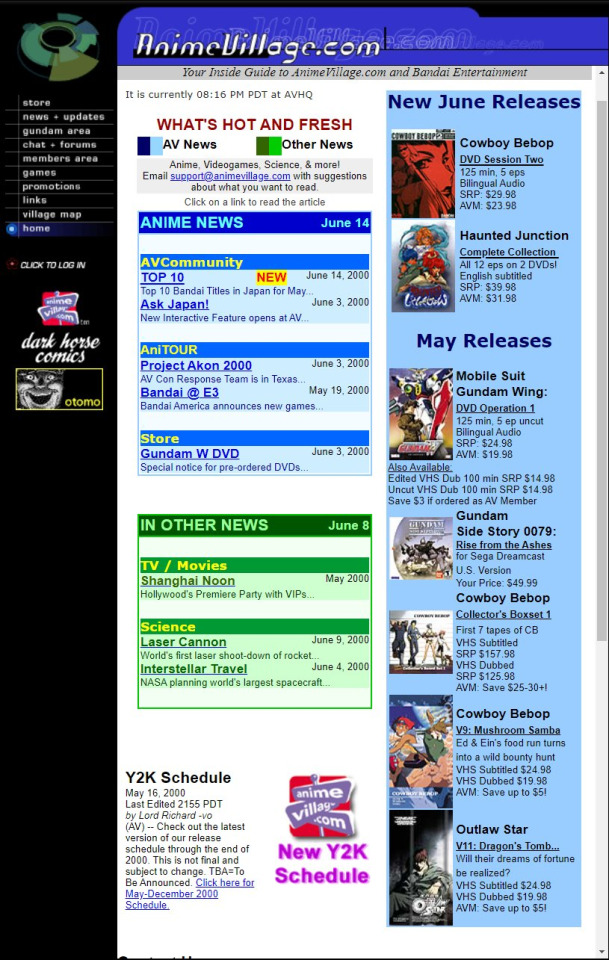
Getting to the actual magazine itself though, there's just two things that I find interesting with the Table of Contents. Firstly, right at the bottom, just above the "Printed in Canada" statement, Viz offers a disclaimer (which you can't read here because of nasty Tumblr compression, so I'll transcribe it): "For the purposes of publication in English, the artwork in this publication is in reverse from the original Japanese Version".
Now, I don't have any OG manga volumes that were printed more like graphic novels, so I can't say for sure, but I find this disclaimer interesting. Either, a) this is a general disclaimer Viz gives about the difference between JP and English publication, or b) Viz is required to provide this disclaimer for the materials. Either way it's a very curious piece.
And then there's the "Vizit our World Wide Web Sites at www.viz.com...". Yes, Viz actually printed "Visit" as "Vizit" alongside "World Wide Web sites". Just such a blast from the past as to how the internet was viewed and interacted with.
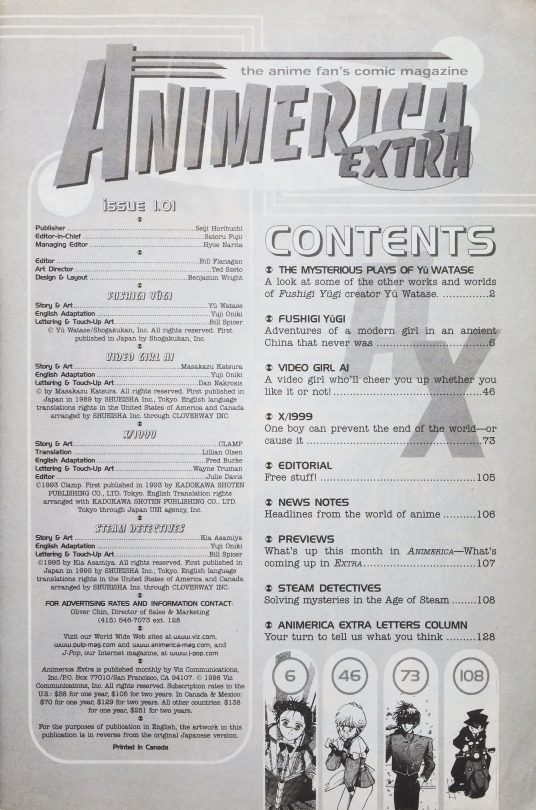
And then there's the Yuu Watase feature from the first issue. I think it's something that doesn't immediately stick out to people in the modern day because hey, you just go to MAL or Manga-Updates and you can see everything that Watase's ever done like it's nothing.
But in the 80s that sort of accessibility was non-existent. I mean, like you'll see later on with the letters, people only found out about Animerica Extra through Animerica. It really highlights how valuable this sort of information was to the community during the era, because you simply just would not know anything about Yuu Watase without these pieces.

Similarly, you couldn't go and look up what a series was about on the internet, you only had word of mouth and direct interaction, so excerpts like these that give readers an idea of what is is they're about to read is incredibly important.
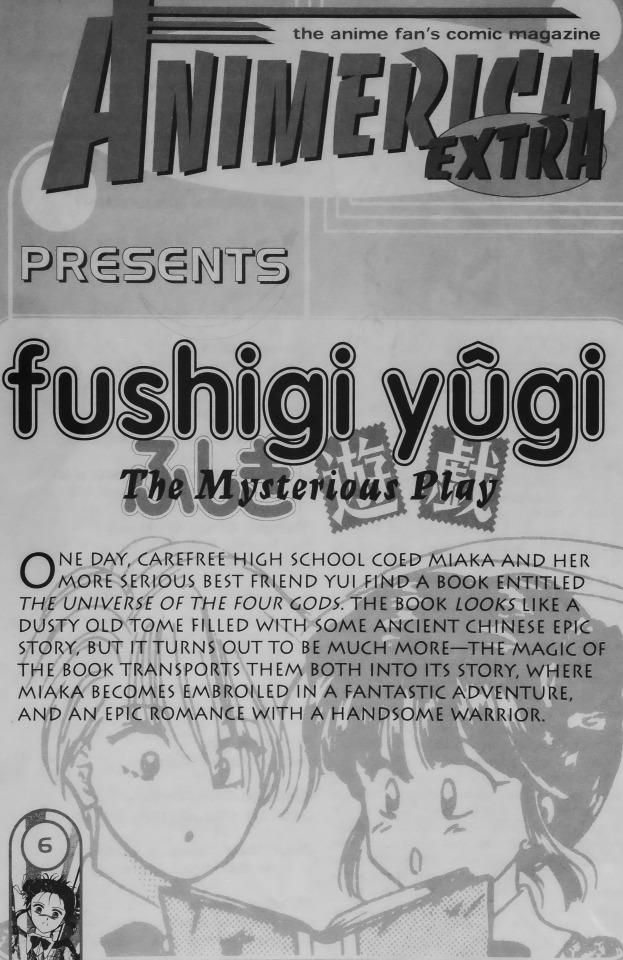
Just a quick aside here about advertisements. I know a lot of people will say, "but hey! There were TV ads during the 90s and 2000s that could be run for this stuff! Surely they could provide information and advertisement via that!", and I think the easiest answer is another question: can the modern day animanga industry manage that? Obviously not, no. The avenues that Viz could approach to advertise via were incredibly narrow, largely focused on anime specific storefronts or general comic stores, placing physical advertisement at the top of the pyramid, followed up by ads distributed via their tapes back in the day.
Anyways, back on track to the editorial for an interesting conversation! This one's very interesting to me for just one thing, really- the original sketch giveaway.
It happens today, rather frequently, but with caveats. It's not, "Hey we're running a giveaway so make sure to participate", it's "Hey we've got X mangaka appearing at a con so come for a chance to win their sketch!". The difference in the approach to the giveaway is entirely different. I don't know if I can really say that it's more accessible, but I think that it gives fans a greater opportunity to participate purely because it's cheaper, running on a far longer schedule (as the editorial mentions), and doesn't require in person attendance for the opportunity.
But to be fair, even those giveaways are only a recent thing as the animanga market's boomed. There was quite a long period of dead air in terms of this sort of activity, so I find it really interesting how the landscape has changed in how these now corporations approach these aspects of interaction with their communities.
Also, here's a link to the archived version of the website in the advertisement on this page.
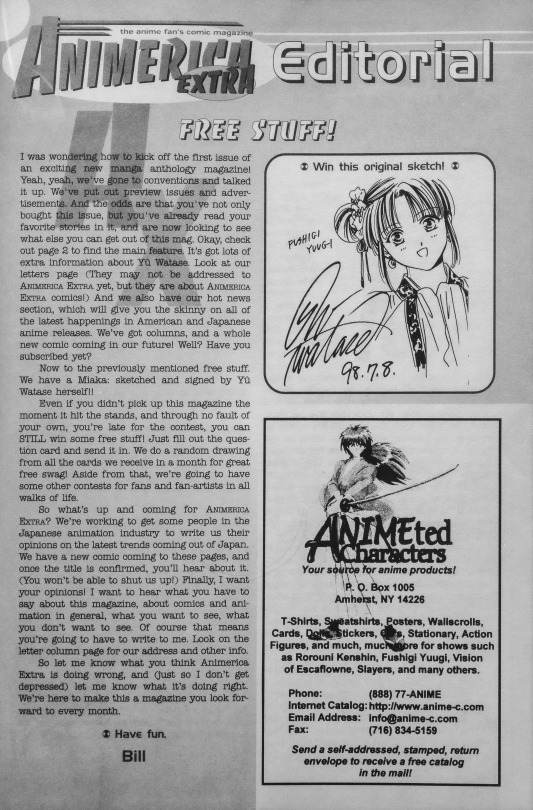
And this magazine really just keeps giving more and more crazy information. This News Notes panel really surprised me. Yes, it's got a lot of plain information like upcoming or finishing anime, but most interesting is the information that the left column provides.
They talk about the mangaka of Steam Detectives appearing at San Diego Comic Con, and not only that, but bringing some early footage of the anime. I mean, that sort of thing has only just begun happening again in the last few years.
It's crazy to see how advanced and engaged Viz was back in the day with the industry overseas. Not that they aren't today, but that the curtain's been pulled across so we no longer get stuff like this in English.
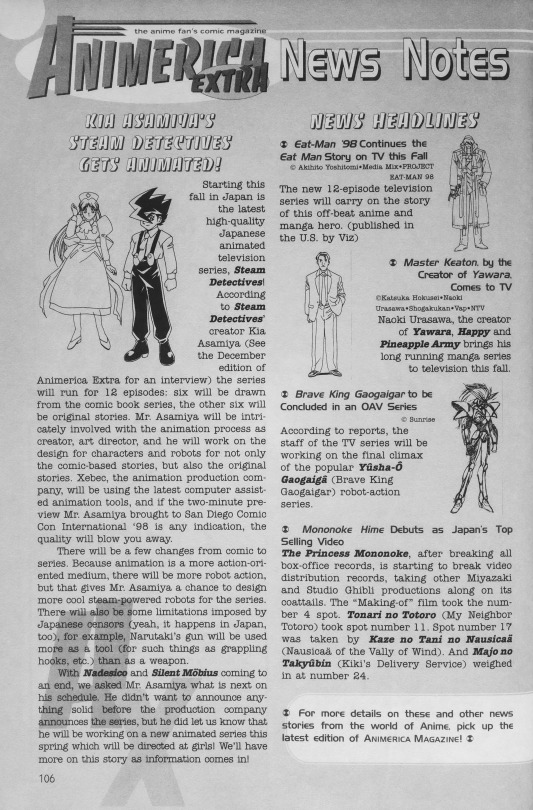
Speaking of things like that, because of the disappearance of things like this, we don't get to see interaction between individuals and the companies. The letters section in this first volume is so interesting because of the era it comes from. The accessibility of information is immediately addressed with the first letter that talks about them finding out about Animerica Extra via the mainline Animerica. Then there's the very talented letter sending that sewed a decorative pillow for their friend. But I think my personal favorite is the nonsensical letter penned by Jonkani.

These magazines are just a gold mine of history and culture pertaining to the North American animanga industry and community, that I really think is important to be able to experience and understand as it contextualizes where this slice of entertainment lies in the modern day.
And this just the first issue of the first volume, there's still 73 more to go that provide all sorts of wonderful and curious information and interactions. Incredibly happy to be able to provide this to the community, but also very hopeful that being vocal with this will both make people more aware of a history that is "ours", and inspire those that have pieces of history like this to archive them.
#animerica#animerica extra#manga magazine#viz manga#viz#viz media#manga#anime and manga#shoujo manga#shoujo#shojo manga#manga history#anime history
9 notes
·
View notes
Text
ANIMERICA EXTRA - December 2003 Issue YASHA Feature!
There were many other YASHA features during the short runtime of the ANIMERICA EXTRA Magazine Viz Media had published, and I hope to post them when I am able! This post will be updated later with links to the original sources I had gotten these images from once I have properly archived them. For now— here is a transcription below the image!
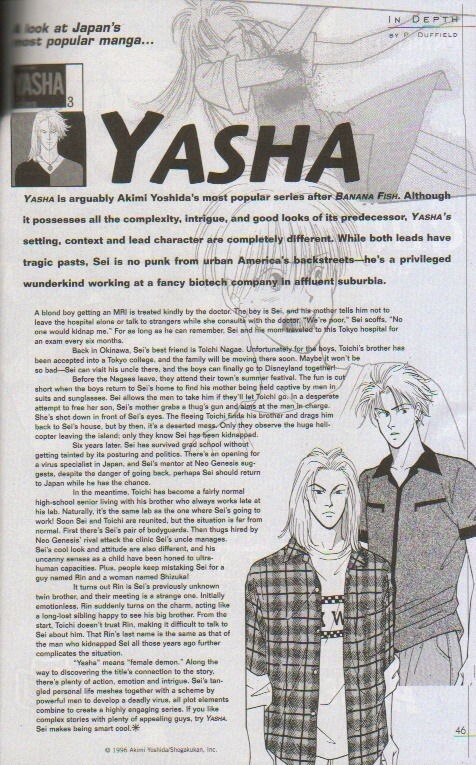
YASHA
A look at Japan's most popular manga…
YASHA is arguably Akimi Yoshida's most popular series after BANANA FISH. Although it possesses all the complexity, intrigue, and good looks of its predecessor, YASHA's setting, context and lead character are completely different. While both leads have tragic pasts, Sei is no punk from urban America's backstreets—he's a privileged wunderkind working at a fancy biotech company in affluent suburbia.
A blond boy getting an MRl is treated kindly by the doctor. The boy is Sei, and his mother tells him not to leave the hospital alone or talk to strangers while she consults with the doctor. "We're poor." Sei scoffs, "No one would kidnap me." For as long as he can remember, Sei and his mom traveled to this Tokyo hospital for an exam every six months.
Back in Okinawa, Sei's best friend is Toichi Nagae. Unfortunately for the boys, Toichi's brother has been accepted into a Tokyo college, and the family will be moving there soon. Maybe it won't so bad—Sei can visit his uncle there, and the boys can finally go to Disneyland together!
Before the Nagaes leave, they attend their town's summer festival. The fun is cut short when the boys return to Sei's home to find his mother being held captive by men in suits and sunglasses. Sei allows the men to take him if they'll let Toichi go. In a desperate attempt to free her son, Sei's mother grabs a thug's gun and aims at the man in charge. She's shot down in front of Sei's eyes. The fleeing Toichi finds his brother and drags him back to Sei's house, but by then, It's a desserted mess. Only they observe the huge helicopter leaving the island; only they know Sei has been kidnapped.
Six years later. Sei has survived grad school without getting tainted by its posturing and politics. There's an opening for a virus specialist in Japan, and Sei's mentor at Neo Genesis suggests, despite the danger of going back, perhaps Sei should return to Japan while he has the chance.
In the meantime. Toichi has become a fairly normal high-school senior living with his brother who always works late at his lab. Naturally, It's the same lab as the one where Sei's going to work! Soon Sei and Toichi are reunited, but the situation in far from normal. First there's Sei's pair of bodyguards. Then thugs hired by Neo Genesis' rival attack the clinic Sei's uncle manages. Sei's cool look and attitude are also different, and his uncanny senses as a child have been honed to ultra-human capacities. Plus, people keep mistaking Sei for a guy named Rin and a woman named Shizuka!
It turns out Rin is Sei's previously unknown twin brother, and their meeting is a strange one. Initially emotionless, Rin suddenly turns on the charm, acting like a long-lost sibling happy to see his big brother. From the start, Toichi doesn't trust Rin, making it difficult to talk to Sei about him. That Rin's last name is the same as that of the man who kidnapped Sei all those years ago further complicates the situation.
"Yasha" means "female demon." Along the way to discovering the title's connection to the story, there's plenty of action, emotion and intrigue. Sei's tangled personal life meshes together with a scheme by powerful men to develop a deadly virus, all plot elements combine to create a highly engaging series. If you like complex stories with plenty of appealing guys, try YASHA, Sei makes being smart cool.
#yasha-夜叉-#Yasha 1996#Akimi Yoshida#Yasha#Yasha (Yoshida Akimi)#Sei Arisue#Rin Amamiya#Toichi Nagae#ANIMERICA EXTRA#What...What tags do I use#This is going to be a steady process#a learning curve if you will
7 notes
·
View notes
Text

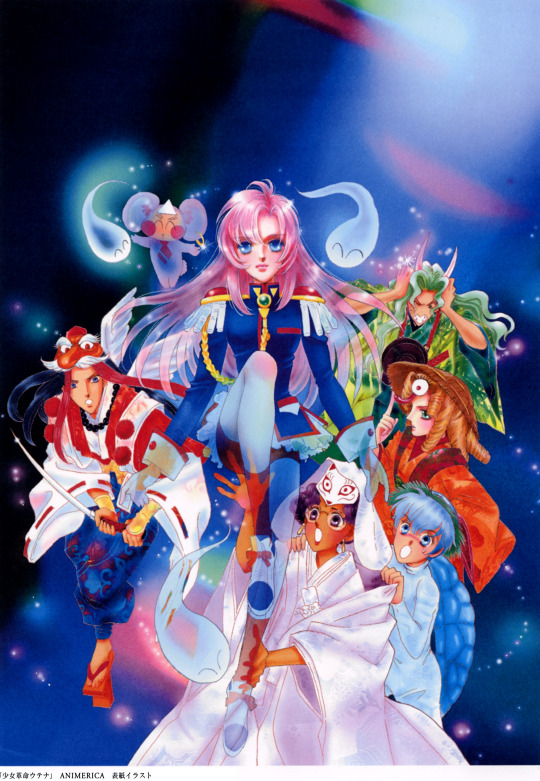
HALLOWEEN COURTESY OF CHIHO SAITO DRAWING REVOLUTIONARY GIRL UTENA FOR ANIMERICA EXTRA, SCANNED FROM HER NEE LA ROSE ARTBOOK
#revolutionary girl utena#utena#shoujo kakumei utena#rgu#sku#utena tenjou#anthy himemiya#halloween#empty movement
573 notes
·
View notes
Text
Today I had the surreal pleasure of finding some 1999 issues of Animerica Extra in a vintage and collectables shop


I love stuff like this, they're such great time capsules of early fandom and the licencing landscape. Look, there's a whole article about how strange and exciting it is that they make manga just about food. You heard of this? Far out!
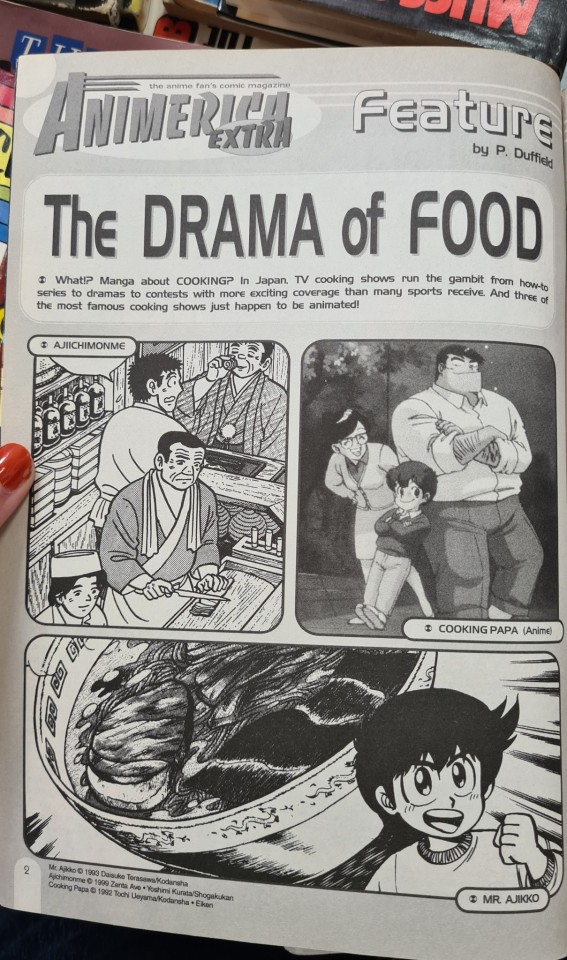

And you can order these super cool new titles NOT FOR KIDS on VHS by MAIL ORDER! Cutting edge!
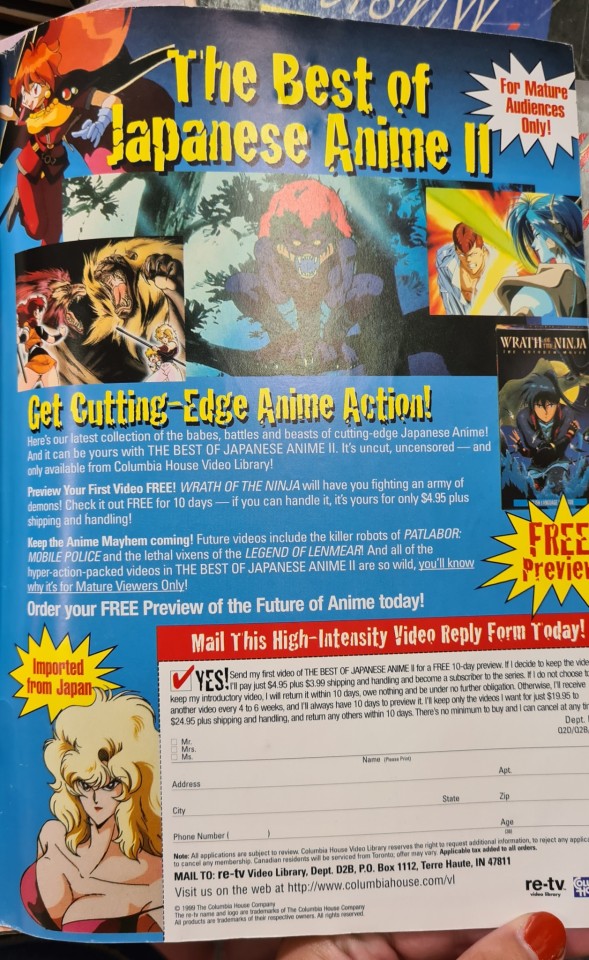

Most interesting for me, these issues had a couple of chapters from the Utena manga! Empty Movement will have all these archived somewhere so I won't post every page, but isn't it wild to see this series here, in the context a lot of English-language fans would have discovered it for the first time? Look at that drama! Why is the font like that??


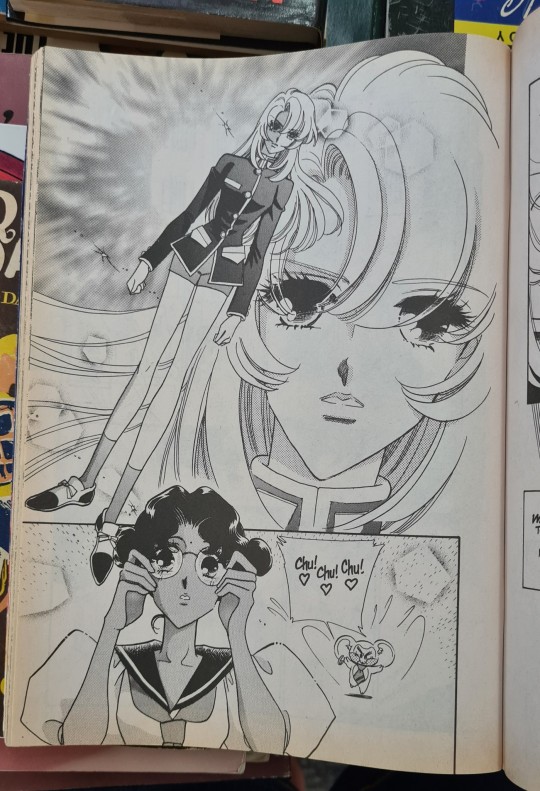
I've heard that the manga is quite different and a lot of people have issues with it, but I will say they DO look great in this classic shoujo style. Even gremlin Chuchu down there
One final sample because this made me laugh:
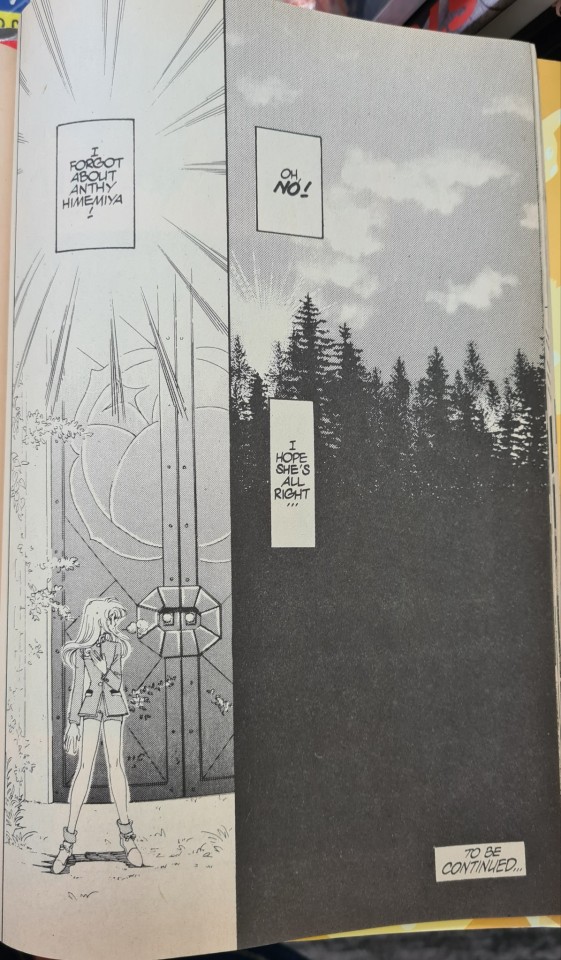
"Oh no, I forgot about Anthy!" Utena has never been less relatable. Couldn't be me girl
45 notes
·
View notes
Text
Post 2- Queer Girl Utena, part 1: The gender nonconforming prince.
Today I wanted to talk about a staple in yuri and shoujo: Revolutionary Girl Utena, personally one of my favourite works of all time.
Created by the group Be-Papas, assembled primarily for this project, this work consists in a manga (1996), an anime TV series (1997) a Sega Saturn game (1998) and a movie (1999).
In this post and the following part I will be discussing mainly the TV series. If I might talk about any other work, it will be stated explicitly.
This story follows 14-year-old Utena Tenjou, whose parents died when she was young, so she was saved by a prince from all that sadness. Somehow, she ends up entangled in a series of duels in order to defend (and keep by her side) the Rose Bride, Anthy Himemiya.
THE GENDER NONCONFORMING PRINCE
As the story says, she was so amazed by the prince who saved her life that she vowed to become a prince herself. “But was it such a good idea?”
Utena is scolded more than once for wearing “a boys’ uniform”, but her uniform is neither the boys’ or the girls’ uniform.

Ohtori Academy's actual boys' uniform
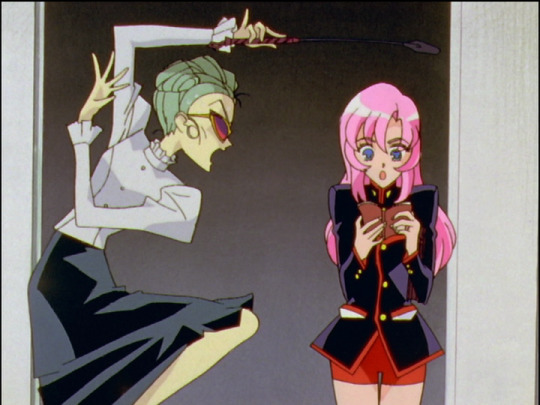
Utena reading on the school rules how it is allowed for a girl to wear a boys' uniform
"With Utena, the main character wears a male uniform--but it isn't really a male uniform, is it? It's just the clothes that Utena likes. She's not bound by the same male/female conventions that previous characters may have been bound by. I don't think that society has changed all that much, but in modern manga, a person is all allowed to follow her own path." - Ikuhara on an interview with Animerica Extra, year 2000
Revolutionary Girl Utena often explores gender non-conformity not only on a visual level with elements like her uniform, but also with Utena’s role and aspiration to become a prince. She wants to save Anthy, she wants to be noble and defend everybody, she is good at sports and very popular among other girls – qualities that of course a woman could fulfill, but they are often performed by and symbolic of men.
She doesn’t see herself as a masculine person, as she acts surprised when Nanami calls herself “boy-girl”.
In the 1999 movie, we can see her with a different look: Her hair made seem like it’s short (though it’s not), a “male” uniform with long pants this time and even we have an awkward moment when Saionji confuses her for a man.

Utena's uniform in Utena The Movie (1999)
FITTING IN THE MOLD, BETRAYING WHO YOU ARE, FITTING IN THE OTHER MOLD
I think it is really interesting to see how she finds trouble keeping up the aspiration of becoming a prince with all that it means since she is still looking for her own prince and finds herself completely disarmed when the thought of finding him is presented to her. She “betrays” Anthy, and saving her starts to matter a little bit less when she wonders if Touga could be her prince (of course, manipulated by him) and when Akio shows romantic and sexual interest for her too, becoming her first love (and an older one, too). These men try so hard for her to be the princess of their stories and, of course, as she has lived in the same system we have all lived in, she is conditioned to do so.
This is something that many gender nonconforming and trans people have lived through: You can still have elements that were forced onto you by society, but they mean something different for you, they just don’t deny who you are. Just like a transwoman can have a beard and still be a woman, or a transman can wear makeup and still be a man, or any nonbinary person can do something that relates to their assigned gender and still be nonbinary, Utena could have been so much happier if someone had told her that she could kiss other princes and still become a prince.
But that is never the case, and those seemingly “girly” instincts are a penintence to her sometimes. When she loses to Touga and her prince uniform has been scratched, she wears the school girl’s uniform. That episode was painful to see, she really is seeing herself having failed in being just who she is, in not having proven that she could be a prince and not a girl, just because for a moment she was happy with the idea of Touga being her prince and liking it. She also felt as she has failed her own princess and, the ugly truth is that they live in a system where that is actually true.
Of course that was Touga’s plan for winning the duel, but how would have things gone if Utena knew that she could love Touga outside the dueling arena without that interrupting her fighting for Anthy’s freedom and security? Of course, Anthy won’t forget that either when she sees Utena being attracted to Akio.
On the other hand, there is a language level of it all. In Japanese, Utena uses the “boku” first person pronoun to refer to herself, which is normally used by men exclusively. This is something that never changes, not even when she is about to be kissed by Akio or taken to a hotel with him.The language aspect of it all stays with her until the very end. Very rewarding and affirming to watch.
WHEN WOMEN’S LIBERATION AND GENDER NONCONFORMITY CLASH
When women in fiction are presented with the “you cannot do that because you are a woman” statement and they work against it, taking the steps only a man is expected to take, it is of course proof that women can do anything and fulfill every role, e.g., you do not need to be a prince (masculine) to save other women, to have a noble attitude, to defend people and what you stand for, to fight.
I really did want to stress that because I would never want to state things like “She is wearing a blazer instead of a dress, that is so not a girl from her” as to state the gender nonconformity about her.
Ikuhara: During the Rose of Versailles, by wearing the uniform, (Oscar) his her own body line--her own femininity. But now, times have changed. Even though it's not yet a world where all women are free, this costume might allow her the chance to be a "woman." We're trying to envision a world where a woman can decide what she does with her own body. Utena decided to show off her own beautiful legs. She's comfortable with her own beauty. That's the type of world we were trying to portray. - Ikuhara on an interview with Animerica Extra, year 2000
With that being said, I speak from myself as a nonbinary transmasc-leaning person and I know for a fact that other fellow nonbinary and trans people feel the same: When we see those traits being displayed, it does resonate with us.
We see ourselves in those actions, those elements, those steps, because we have experienced that too.
That leads us to the next question:
AM I SAYING UTENA IS NOT A WOMAN?
The short answer is no. As I previously stated, I reckon these elements were created to make Utena a free woman, free from what society says a woman can or cannot do. But, knowing Ikuhara wanted to include queer elements on the anime (even if it was just to symbolize other minorities), I also do think the genderfuck element of it all definitely exists and is not just a headcanon.
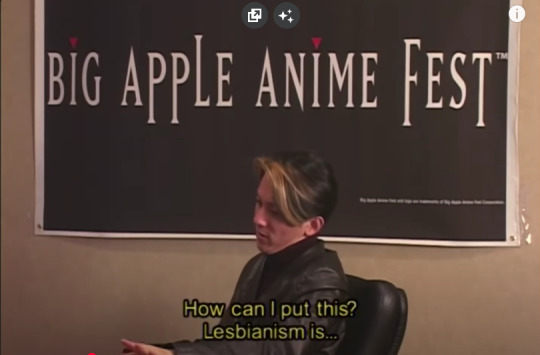
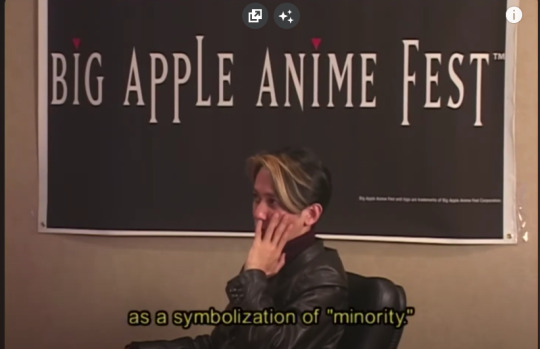
And I don't really care if it is not canon: The gender deviance aspect of Utena speaks directly into my soul.
I would really like to know other people’s opinion on this matter, and what else is very gender about Utena for you. Come yap with me, please!
#revolutionary girl utena#rgu#utena#utena tenjou#anthy#anthy himemiya#lgtbi#lesbian#wlw#yuri#gender nonconforming#nonbinary#clothes#gay#kunihiko ikuhara#lgtbqia+#lgtbtq#lgtbq community#otaku#queer#2025 resolutions
17 notes
·
View notes
Text
i think what really needs to happen is the return of translated physical anthology magazines. animerica extra, pulp, raijin comics, shonen jump, and so on.
then you can pair up lesser known series and series with premises that might not be easy sells with big name series and more people'll read the weird stuff because it's right there in the same mag as the popular stuff they bought the mag for.
i think the lack of these magazines really does hurt english language manga fandom for this and many other reasons. as it currently stands, if you're an english language reader, you're either buying only the series you're interested in as volumes, or paying for something like the shonen jump app and probably still only reading a few series on there, because even in the same app, they're still totally seperated from each other.
with how much manga is published in Japan, i don't think the translation publishing industry without fan translations to serve as a vetting process. there are 40+ volume manga that ran for decades that you've never heard of because they never got translated. the well is unfathomably deep. but if something gets a fan translation and becomes popular that way, it can be a sure bet to license
these companies put out interest surveys and they definitely check these websites for what's popular. the industry wouldn't function without fan translations
7K notes
·
View notes
Photo

NEE LA ROSE - Chiho Saito (x)
536 notes
·
View notes
Photo





Up now on my eBay! Various translated manga comics from 1994-2001! Animerica Extra from Viz Media, Astrider Hugo from Radio Comix, and Dodekain from Antarctic Press! Also up for grabs: my superheroine comic collection (70’s-80’s stuff), random Radio Comix books and various indie comics! My house is super small, and I am still selling off thirty years’ worth of collectibles to raise money for ongoing back taxes & upcoming convention expenses, so every little bit helps. Thanks for looking & sharing!
#comics#manga#animerica extra#viz media#steam detectives#fushigi yugi#video girl ai#marionette generation#astrider hugo#radio comix#dodekain#antarctic press#studio do-do#masayuki fujihara#hisao tamaki#1994#1995#2000#2001#vintage comics#auctions#ebay#buy my stuff!
3 notes
·
View notes
Text
english language manga anthology print magazines
manga mania
manga heroes
super manga blast
manga vizion
animerica extra
pulp
chibi-pop manga
smile*
mixxzine
tokyopop
yen plus
doujinshi**
that’s all i know of, all of which are uk or north america-based. i know there was a singapore company called chuang yi that printed manga in english, though i don’t know if they put out any magazines, or if they only did collected volumes.
*this was a general magazine aimed at young girls, that also had some manga in it. i think it later dropped all the non-manga stuff, though?
**this was a weird title put out by antarctic press for a short time in the early 90s that printed translated comics and art from various japanese doujinshi. each issue was themed around fanworks of a different series: nadia, transformers, etc. copyright troubles are what killed it, though AP did also put out a one-shot magazine called justice, which had translated articles from doujin created by japanese fans of american superhero comics. justice is a very interesting item, i recommend tracking down a copy.
7 notes
·
View notes
Text
Animerica Extra Volume Two Issue One
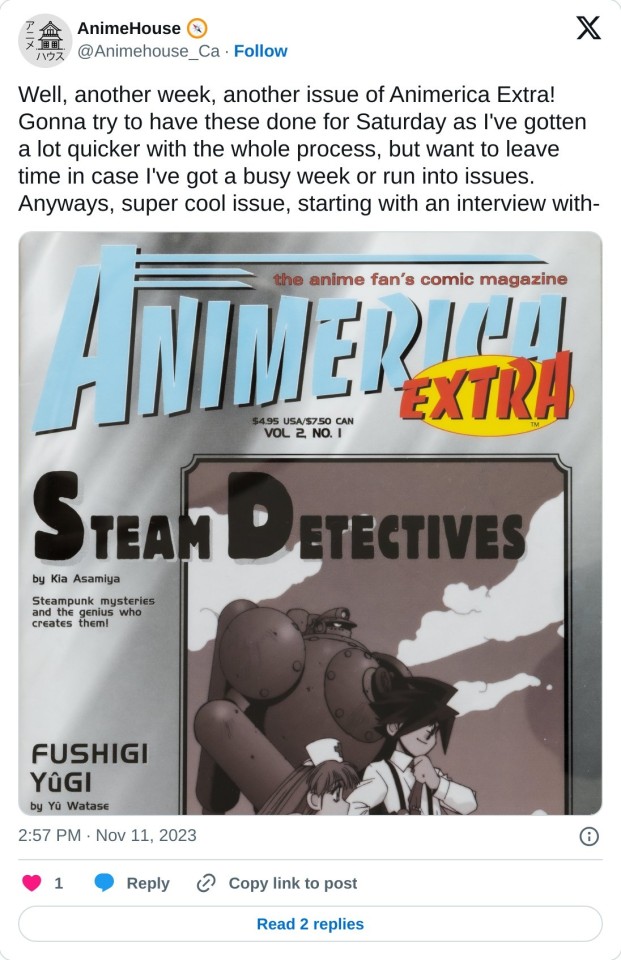
Ended up writing a bunch out on Twitter, so just going to cheat a little and say go check out the thread on Twitter haha. This is the first of the "real good" issues of Animerica Extra, as it has a (what I believe to be) exclusive interview with the mangaka Kia Asamiya, which unearths a lot of interesting information. Definitely worth checking out.
Though, if you just want to read the issue without my commentary on it, then feel free to check out the issue on the Internet Archive.
#animerica#animerica extra#manga magazine#viz manga#viz#viz media#manga#anime and manga#shoujo manga#shoujo#shojo manga#manga history#anime history
4 notes
·
View notes
Text
Okay, So— Yikes! Turns out after reaching out to Viz Media (and talking with a really sweet employee!) Viz Media doesn't hold any physical or digital archives of past magazines. All in all it's not the worst thing, as there are still secondhand copies out there...but it will be a longer process and take a lot of digging. Lots of hope though! On the up side, I did get ahold of some issues for ANIMERICA EXTRA. Specifically one of the February releases that had another YASHA feature! I am excited to make a future post about it, even if the contents are super brief!
#ANIMERICA#ANIMERICA EXTRA#Toichi.txt#Also plan to make more posts coming up soon....lots of YASHA things to post about#Hoping to also archive these issues as a lot of them are apart of bigger fandoms with more of a following#such as Revolutionary Girl Utena and Banana Fish
4 notes
·
View notes
Text
I think I did a lot of BF fanfic back in the day because I was 18 - 20 and the main characters were about my age and resonated with me especially since I was starting on my journey to figuring out I'm not straight. So now that I'm 33 it's more like a nostagia train hit me and is dragging me down the tracks. I've been using restraint though because I feel like maybe I'll produce better work if the anime helps jog my memory because I was a dumbass when we moved from Indiana to Georgia and gave away the volumes I owned because I forgot I also had chapters in my Animerica Extra magazines that I kept.
That said, I really want to go somewhere with the concept Angela on AO3 put forth in a fic recently about the darkness within Ash especially since it's a thought I was thinking about before I kind of had to give up writing fic all together due to university and health problems, but I think I'll let it cook a little longer. It might end up becoming fanart instead at this rate.
It's interesting to me though how I was able to just launch myself back into things and latch back onto my faves so easily even though it's been so long since I last reread the manga.
14 notes
·
View notes
Note
what on earth is this banana fish stuff it looks good but i literally cant find it anywhere
Banana Fish is a comic by Akimi Yoshida that was serialised 1985-1994 in Japan, and was first released in North America through serialisation in Viz’s now-defunct Animerica Extra magazine in 1999; the anime just premiered July 5th and it’s the first anime ever for this comic. (I waited so long ;-; ! Almost twenty years!)
The anime is released on Fuji TV in Japan and Amazon Prime Video internationally, but you can find it on gogoanime for free; that’s where I watch it because a) I don’t have Amazon Prime Video and b) even if I did, there’s no guarantee that Canadian APV would have it, since we frequently get shafted by streaming services.
I hope that helped, anon! :)
5 notes
·
View notes
Photo
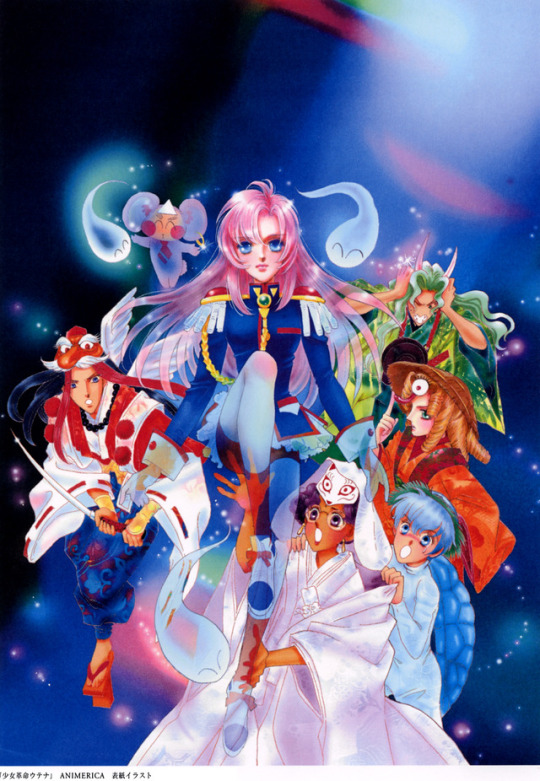
Revolutionary Girl Utena art by Chiho Saito for Animerica Extra Magazine
779 notes
·
View notes
Text
Saito: The image of what is female seems to be evolving from Princess Knight, to Rose of Versailles, and on through Utena. During Rose of Versailles, the main character would not only wear men's clothes, she also had a male mindset. And in the setting, it was considered a problem if a woman tried to advance herself in society. This was the world of Rose of Versailles. But now with Utena, the main character wears a male uniform--but it isn't really a male uniform, is it? It's just the clothes that Utena likes. She's not bound by the same male/female conventions that previous characters may have been bound by. I don't think that society has changed all that much, but in modern manga, a person is all allowed to follow her own path. Animerica Extra: No, it isn't a man's uniform. The male characters wear nothing like it... Ikuhara: During the Rose of Versailles, by wearing the uniform, (Oscar) has her own body line--her own femininity. But now, times have changed. Even though it's not yet a world where all women are free, this costume might allow her the chance to be a "woman." We're trying to envision a world where a woman can decide what she does with her own body. Utena decided to show off her own beautiful legs. She's comfortable with her own beauty. That's the type of world we were trying to portray. Saito: We tried to make a costume that showed how beautiful a woman can be. Animerica Extra: So how much do you think society has advanced? Saito: It's not necessarily true that women are gaining a stronger place in society. It's possible that they don't have a stronger position at all. But at the very least, it seems that now is a time when a woman can decide how to show the world her own feminine beauty and be proud of it.
1 note
·
View note
Photo

NEE LA ROSE - Chiho Saito (x)
340 notes
·
View notes